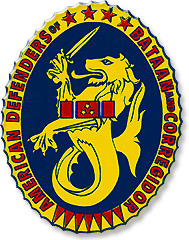
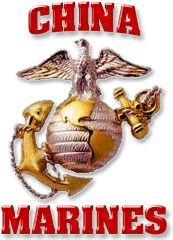
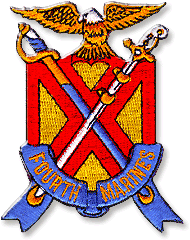
 |
 |
 |
| Fourth Marines Band: "Last China Band" |
|
|
||||||||||||
|
THE LAST CHINA BAND |
||||||||||||
| An account of the 4th Marines Band of the Fourth Regiment of the United States Marine Corps during the final days it served in China since 1937 and before being surrendered to the Japanese at the fall of Corregidor Island, 6 May 1942 during World War II. By: Master Sergeant Donald LeRoy Versaw / United States Marine Corps / Retired | ||||||||||||
|
TABLE OF CONTENTS |
||||||||||||
|
||||||||||||
|
||||||||||||
|
|
||||||||||||
|
Outdoor Marine Band Concert at the Peking (Beijing) Legation, Summer 1941 |
||||||||||||
|
INTRODUCTION |
||||||||||||
| My
comrades of the Marine Corps Musicians Association prompted me to write
this story. It first appeared in our newsletter. It was apparent that
the story of the only band in Marine Corps History to be given over to
an enemy in war time, needed to be told.
There
were few field bands just prior to World War II. The Marine Corps was
then smaller than the New York Police Force. Marine Corps musicians
were a highly specialized group. Many of the veteran musicians served
with one another in most of the posts and stations where a band was
authorized. New recruits soon learned about old timers no matter where
they were stationed. It is amazing that the fate of our comrades of the
Fourth Marines is still of interest to Marine musicians now as well as
many other friends of our Corps. It has been almost sixty years since
the band sounded its last note and went into history as a rifle
platoon. Of the forty eight members who then made up the band for its
concerts and for parades and ceremonies, only eight are living at the
time of this edition. This is our story. |
||||||||||||
|
ACKNOWLEDGEMENTS |
||||||||||||
| Among
the many that helped me greatly I am pleased to thank them once again.
They are the late George Francis with his insistent urging; Jim Beebe
and my almost life long buddy Lou Curtis, both professional musicians
and Marines to the core. The late Leland Montgomery gave me great
support when I needed it most. My thanks to Phil Dreiseszun, for
editing, helping to make sense out of my first drafts. Carl Bermender
gave me much encouragement helping me along. And to my niece Claudia
Luther of the Los Angeles Times for her editorial help and guidance. I
couldn’t have written this at all without my computer and Noel Roberts
deserves great credit for teaching me the skills to use it. The
beautiful design and cover of this book is the splendid work of Russ
Romain and he is due much thanks, as is his wife, Carlene, who read it
and applied “band-aides” where it was hurting. Consulting by Marine
Corps Musicians Association Historian. This edition is enhanced with a set of six photographs made available to us by Jesse Mann Mastin. We are greatly in her debt for doing so. The story of the Last China Band ends with it playing itself out of the war-threatened city on November 28, 1941. The band appears somewhere in each view and the drama of it shows on each face. This was its last parade. It would join the troops it was leading in its final battle not long after. And another chapter would be added to the book of glory that is the United States Marine Corps. |
||||||||||||
|
DEDICATION |
||||||||||||
| This edition is lovingly dedicated to Amelda, my bride of 52 years, 2 months and 9 days. | ||||||||||||
|
ROSTER OF THE FOURTH MARINES BAND / 1940-1941 |
||||||||||||
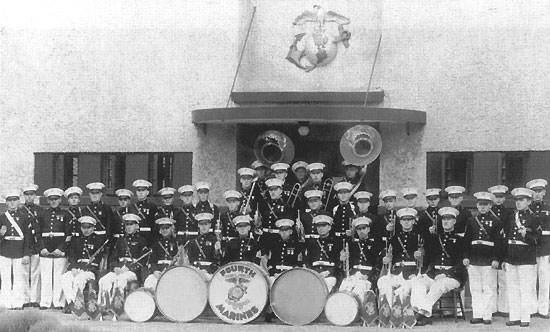 |
||||||||||||
| Fourth
Marines Band Shanghai, China / September, 1940 / 551 Ferry Road Billet |
||||||||||||
|
Cpl. Claude Lester Brent -
Clarinet PFC Artie E. Sanville - Clarinet PFC William. E. Harrison - Clarinet FM Sgt. Wm. j. McClung III - NCO in C Bugle & Drum Corps TSgt. Jackson P. Rauhof - Drum Major MFSgt. Levis E. Giffin - Bandmaster Sgt. Frederick L. Mayberry - Percussion / Instrument Repair Cpl. George Francis - Trumpet PFC Sp/4c Steven A. Jones - Trumpet PFC Sp/5c John F. Sirota - Trumpet Pvt. Sp/5c Robert S. Newsome - Trumpet FM Robert E. Follendorf - Bugle / Drums FM Martin D. Eichman - Bugle / Drums PFC Sp/5c Floyd E. Grim - Percussion FM Bernie D. Pitts - Bugle / Drums Pvt. Sp/4c Hal T. Leber - Clarinet FM I/c Frederick Stumpges - Bugle / Drums PFC Sp/5c Leland H. Montgomey - Clarinet FMC CpI. William H. Adams - Bugle / Drums PFC Sp/5c John J. Lawson - Clarinet FM Warren H. Mellies - Bugle / Scotch / Tenor Drums Pvt. Sp/5c Donald L. Versaw - French Horn Pvt. Sp/4c Arnold S. Baker - French Horn PFC Anthony Stankitis - French Horn FM 1/c Harry C. Dunlavy - Bugle / Scotch / Tenor Drums Pvt. Sp/5c George McRae - Trumpet Pvt. Pat Bennet - Trumpet Pvt. Sp/5c Mercurio Coledanchise - Baritone Horn FM Melvin Mikkelson - Bugle / Drums FM 1/c Melvin J. Zhaler - Bugle FM 1/c Rodger D. Baker - Bugle FM. Wesley LeB. Usher - Bugle / Drums PFC Sp/3c Gerald P. “Mickey” Finn - Percussion PFC Sp/5c Donald F. Scott Percussion Pvt. Sp/4c Victor 0. Lundgren Trombone Additional duty as Chaplain’s Assistant / Leader of congregation Singing at Devine Services Pvt. Sp/5c James W. Higley Sousaphone PFC Sp/4c John Snyder Trombone / Library PFC Sp/4c Hubert H. Johnson Baritone Horn PFC Sp/5c Sydney A. McMullen Trombone Pvt. Sp/5c Charles F. King Sousaphone |
||||||||||||
 |
||||||||||||
| Fourth
Marines Band Shanghai, China / September, 1941 |
||||||||||||
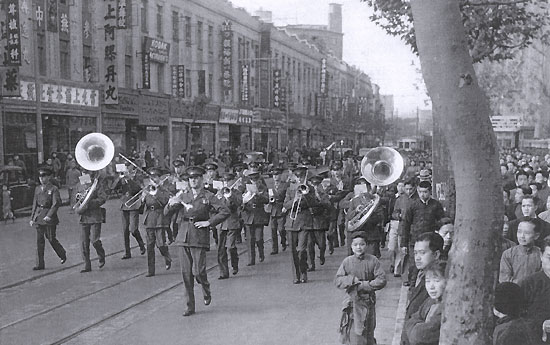 |
||||||||||||
| Shanghai, China / 28 November, 1941 | ||||||||||||
|
The Fourth Marines Band leads the troops from the First Battalion down East Nanking Road leaving the International Settlement where Marines had been stationed since 1937. Drum Major, TSgt. Jackson P. Rauhof is seen in front of the band with his mace. At the extreme left MTSgt. Levis E. Giffin, the Bandmaster, marches in a lone column. Others in the front rank are: George Walker, Sousaphone; Sydney McMullen, Monford Charleton; Cedric Stephens playing Trombones. Charles King with Sousaphone is at far right. In the second rank: John Sirota, Trumpet; John Bingham and Donald Versaw (barely visible behind Stephens), French Horns. Third rank: Kenneth Marshall, Clarinet; Pat Bennett, Francis Hooker, Trumpets. This was the last marching event performed by the band as it made its way to the city’s famous waterfront, The Bund, with the troops to board U.S. President Lines ships anchored in the river just off shore. |
||||||||||||
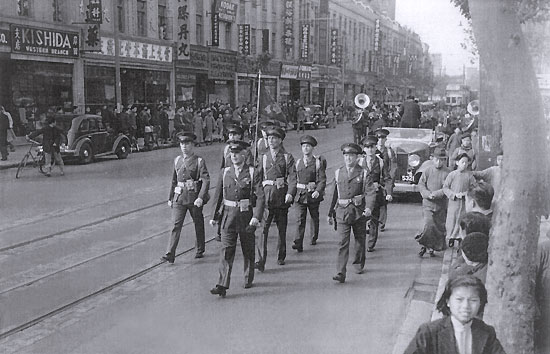 |
||||||||||||
| Shanghai, China / 28 November, 1941 | ||||||||||||
|
The Fourth Marines leave the International Settlement of China’s famed “Paris of the Orient” as relationships with the Japanese Forces surrounding the city are in jeopardy and the threat of war increases. Marines had been there protecting the lives and property for many years. The famous 4th Marines were a part of these forces since 1937. In this view Colonel Samuel Howard and his staff lead the way through down the colorful street called Nanking Road followed by troops of the First Battalion. An open Rolls-Royce in rear of the staff of nine officers and men of Headquarters Fourth Marines has entered the line of march to photograph the band led by Drum Major Jackson P. Rauhof and Master Technical Sergeant Levis E. Giffin, the bandmaster. The Second Battalion had departed the previous day during a rainstorm and waited aboard ships anchored in Shanghai’s river harbor of the Whangpoo. The entire organization then departed in the late afternoon destined for the Philippines. |
||||||||||||
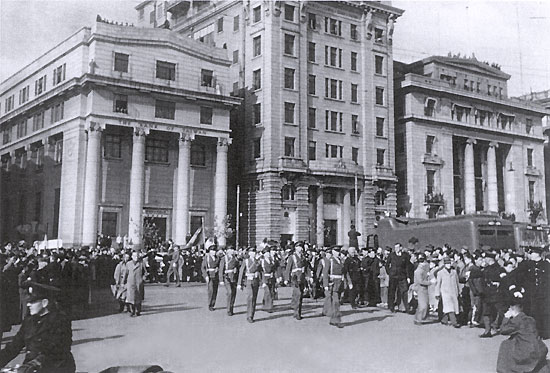 |
||||||||||||
| Shanghai, China / 28 November, 1941 | ||||||||||||
|
The last echelons of Fourth Marines arrive at the world renowned waterfront street called THE BUND. The distinctive Western style bank and office buildings form a classic backdrop for the departure from the headquarters led by Colonel Samuel B. Howard. The Fourth Marines Commander and his staff are shown as they emerge from crowded street canyons of the great city. In the far background at the foot of the Bank of Taiwan, Drum Major Rauhof can be seen executing a “Band, Column Left!” command. To the extreme right a Shanghai Metropolitan Police Mobile Command Post vehicle is on site to help with crowd control. |
||||||||||||
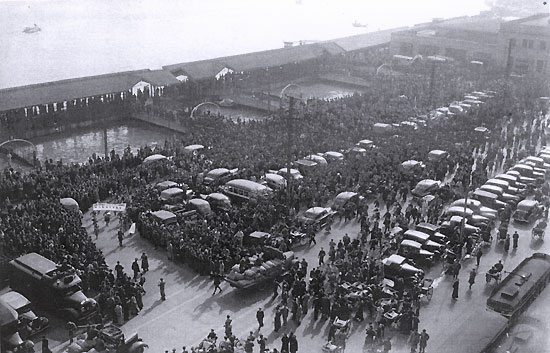 |
||||||||||||
| Shanghai, China / 28 November, 1941 | ||||||||||||
|
Birds eye view of quay(s) on the banks of the Whangpoo River, the port of Shanghai during the farewell of the Fourth Marines as it prepares to leave the International Settlement. Throngs of people are seen gathered among the limousines of the world’s diplomatic, consular force and business firms watching troops of the First Battalion arrive led by the Fourth Marines band (note: Sousaphone base horns just to left of picture center). Plainly seen in the line of march carrying a large banner are elements of Shanghai’s Volunteer Defense Force wearing kilts and playing bag pipes. Shortly after this resounding, amazing and confusing send off, the Marines departed for the Philippines ending their duty in Shanghai after many years. |
||||||||||||
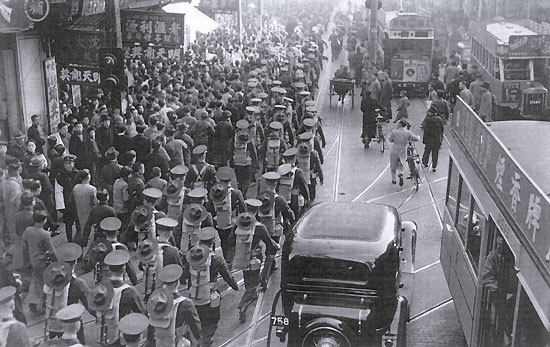 |
||||||||||||
| Shanghai, China / 28 November, 1941 | ||||||||||||
|
Troops of the First Battalion, Fourth Marines march down Nanking Road, on their way to the quays of the Whangpoo River preparatory to embarking on U. S. President Line ships for the Philippine Islands. The Marines share the crowded streets with examples of every mode of transportation available. The troops are carrying “Heavy Marching Order” packs topped with neatly blocked campaign hats, armed with Springfield 1903 rifles at the left shoulder. Beneath each hat is the standard issue foul weather gear called a “pancho” and entrenching tool. At the head of this column pictured, the Fourth Marines Band can be seen breaking out into brighter sunlight. This proved to be a false foreboding as this historic field band would cease to be one in only ten more days. |
||||||||||||
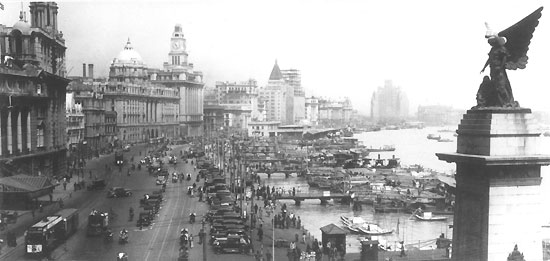 |
||||||||||||
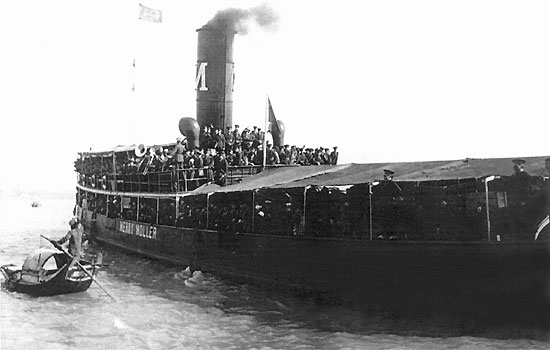 |
||||||||||||
| Shanghai, China / 28 November, 1941 | ||||||||||||
|
A lone Chinese sampan escorts a ship tender, the Merry Moller carrying troops of the Fourth Marines from banks of the Whangpoo River to American President Liner, SS President Harrison, anchored in deeper water. Among the troops were all of the First Battalion and the staff of regimental headquarters. The Fourth Marines Band is easily located on the top deck. |
||||||||||||
| ROSTER
OF THE PEKING LEGATION AND FOURTH MARINES BAND MUSICIANS Peking (Beijing) and Shanghai China / 1940 - 1941 Killed in Action Sim Ashburn Popejoy FM 1 c Claude L. Brent Cpl John W.Bingham Sgt Levis E. Giffin MTSgt William F. Fryer PFC Jesse E. Grenz PFC John F. Sirota PFC Harry B. LaPointe Jr. PFC George E. Walker PFC Died in POW Camps Leon Konesky TSgt Donald Scott PFC Charles F. King PFC The Survivors Jackson P. Rauhof TSgt / Drum-Major Mercurio Coledanchise PFC / Baritone Horn Sherwood LaRoche PFC / Percussion John P. Latham PFC / Piccolo/flute Alfred August PFC / Bass Horn Pat F. Bennet PFC / Trumpet George Francis Cpl / Trumpet George McRae PFC / Trumpet Robert Newsome PFC / Trumpet Francis Hooker Cpl / Trumpet Kenneth Marshall Cpl / Clarinet / Saxophone Leland Montgomery PFC / Clarinet Louis N. Curtis PFC / Clarinet Hal T. Leber PFC / Clarinet Franklin Boyer Cpl / Clarinet Monford P. Charleton PFC / Trombone S. W. Stephens PFC / Trombone Sidney A. McMullen Cpl / Trombone Harry Goldstien PFC / Trombone John W. Brannan PFC / Trombone Donald L. Versaw PFC / French horn Anthony Stankitis PFC / French Horn Norman 0. Shire PFC / French horn William
McClung FMSgt / Bugle/drums Frederick Stumpges FM 1 c / Bugle/drums Martin V. Eichman FMcpl / Bugle/drums Harry C. Dunlavy FMsgt / Bugle/drums William H. Adams FN I c / Bugle/drms John K. Corley FMcpI / Bugle/drms Carl F. Girardot FM I c / Bugle/drums Melvin Mickelson FM 1 c / Bugle/drms Bobby Jones FM I c / Bugle/drms Delmar V. Meyers FM 1 c / Bugle/drums Charles Patterson FMcpl / Bugle/drums Bernino B. Pitts FM 1 c / Bugle/drums Melvin J. Zahier FM I c / Bugle/drums |
||||||||||||
|
||||||||||||
|
DONALD
L. VERSAW, born June 23, 1921 in Bloomington, Nebraska. Joined the U.S.
Marine Corps on Armistice Day, 1939 in Chicago. Following recruit
training and a short term with the Marine Corps Operating Base Band,
San Diego, CA, he was sent to Shanghai, China for duty with the 4th
Marines Band. After the regiment was evacuated to the Philippines and
at the outset of World War II, he became an infantryman in E Co. Second
Battalion, Fourth Regiment. When Corregidor was surrendered to the
Japanese in May 1942, he spent the next 40 months as a POW in the PI’s
and in Japan. |
||||||||||||
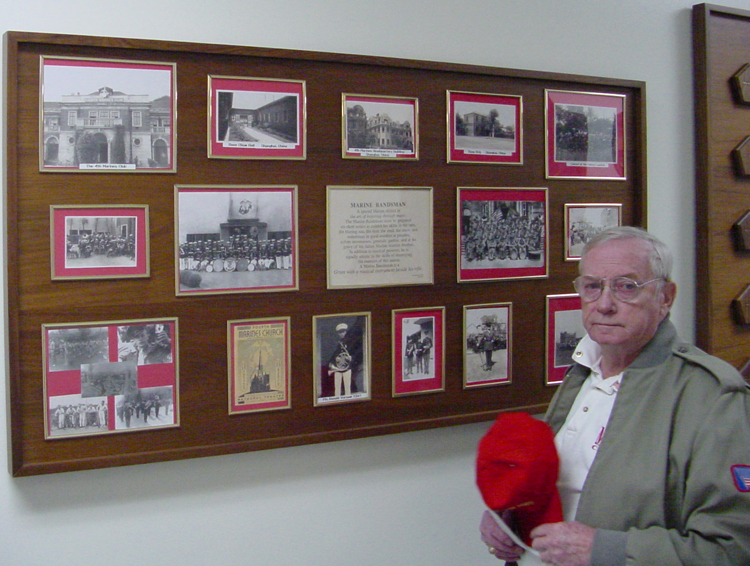 |
||||||||||||
| OTHER
BOOKS AND ARTICLES BY THE AUTHOR Mikado no Kyaku (Guest of the Emperor) Sound of the Bugle The Anvil Chorus |
||||||||||||
| Copyright © 1990 Donald L. Versaw, printed by Marrs Printing, Inc. All rights reserved. No part of this book may be reproduced or transmitted in any form or by any means, electronic, or mechanical, Including photo copy, recording or any information storage and retrieval systems, without permission in writing from the author. Requests for Permission to make copies of any part of this work should be directed to 4407 Adenmoor Avenue, Lakewood, CA 90713. Versaw, Donald L. 1921. First Printing 1990, Second Printing 1991, Third Printing 1993, Fourth Printing 1995, Fifth Printing 2000, Book and cover design by Russ Romain. | ||||||||||||
| Full Text of THE LAST CHINA BAND | Please Click Below for: |
| CHAPTER ONE - China Duty | Page 1 |
| CHAPTER TWO - The “Clouds of War” | Page 7 |
| CHAPTER THREE - In the Philippines | Page 21 |
| CHAPTER FOUR - On Corregidor | Page 31 |
| CHAPTER FIVE - The Battle is Over | Page 41 |
|
|
| Please Click Below To Return To: |
| EMAIL: info@4thmarinesband.com |
| ©2000-2021 lastchinaband.com. All rights reserved. |